Hip Supports and Seat Options
Probably the most important aspect of wheelchair seating is getting the position of the hips correctly positioned. Once the hips are positioned well the other aspects of the seating can be addressed. On this page I've listed several types of supports and positioners that can be used alone or in combination with other products to help the user maintain their hip position.
|
Seat Belts are the most basic and common form of positioning device for wheelchairs. The belt should fit at as close to 45° as possible just like a vehicle lap belt is positioned and should be snug but not too tight. Wheelchair seat belts come with a variety of buckle types from auto style to plastic buckle to Velcro type closures. While wheelchair seat belts are suitable for positioning in a wheelchair they are not suitable for use in a vehicle. The user must always use a seat belt that is attached to the vehicle when being transported. |
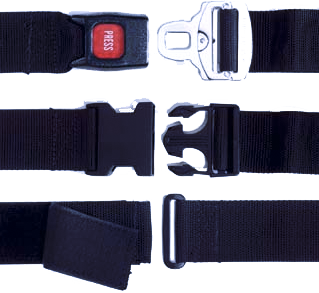 Seat Belts |
Four Point Seat Belts are a more adjustable type of seat belt that provide a more customized fit than a regular wheelchair seat belt. From the front they look similar but the straps that attach to the wheelchair frame divide into double straps on the ends. One of these dual straps is attached to the back post of the wheelchair and the other is attached to the side frame of the wheelchair about midway between the back posts and the front of the seat. With all four straps adjustable, the belt can be adjusted to exert more pressure downwards or backwards as needed. |
 Jay 4 Point Seat Belt |
|
Subasis Bars are padded bars, usually metal, that are positioned across the hips of the wheelchair user to keep them back into the proper position. These bars are mounted onto brackets that are attached to the wheelchair's side frames or seat rails and can easily be removed or flipped up to allow transfers and folding of the wheelchair. Subasis bars are usually the absolute last resort for therapists trying to find a solution for wheelchair users who can't be kept seated properly any other way. |
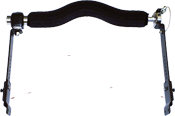 Metalcraft Industries Subasis Bar |
| Hip Guides are used to keep the wheelchair user from shifting their hips sideways in their seat. Sometimes referred to as hip bolsters, they are usually attached to the solid seat pan or seat base but some models attached to the wheelchair arms. They are simply flat padded bolsters that effectively narrow the seat width of the wheelchair and reduce the amount of movement possible. In some models the pad is long enough to act as both an adductor and hip guide. |
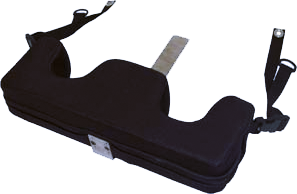 Knee Block |
| Amputee Boards are designed to support the stump of below the knee amputees. They are placed under the wheelchair cushion and the support board slides out to support the user's stump. There are also models where the support board flips down when not is use and can be flipped up when needed. Most come with some sort of pad for comfort but air, gel and foams pads can also be purchased. The boards can usually be set up for use on either the right leg, left leg or both. |
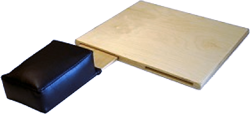 Amputee Boards |
| Drop Bases are platforms the wheelchair cushion can sit on. There were originally developed to provide some seat height adjustment for people who would benefit from a lower seat height than their wheelchair can provide. The drop base consists of a flat board (normally plastic these days) and hooks that come in a variety of lengths. The drop hooks hook onto the seat rails of the wheelchair. The amount off lowering depends on the length of the hooks. A 2" drop hook will lower the seat height by 2", 1½ drop hooks will lower the seat height 1½, etc. In addition to lowering the seat height, many drop bases can be purchased with adjustable drop hooks. I don't know if this is what the manufacturer had in mind but with adjustable drop hooks you can alter the angle of the seat by having the hooks set shorter at the front or back. When the back hooks are longer, the seat is effectively tilted backwards. Having the seat tilted backwards make sliding forward out of the seat more difficult. |
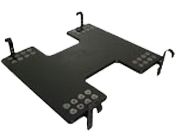 Drop Base |
| Ischial Wells An ischial well is the dip in a wheelchair cushion where the buttocks sit. Rather than being a product or option it is a feature of some cushions. I've included it here because it is an integral feature of hip and pelvis control. All wheelchair cushions that are designed to have positioning properties will have a ischial well. The area where the well transitions to the higher front half of the cushion is called the ischial shelf. When a user begins to slide forward their buttocks bump up agianst the shelf and they stop sliding if the sliding in not too agressive. When a seat belt is used on a cushion that has a deep ischial well it is very difficult for the user to slide forward. |
 Ischial Well |


 Online Vendors
Online Vendors  US Online Vendors
US Online Vendors 